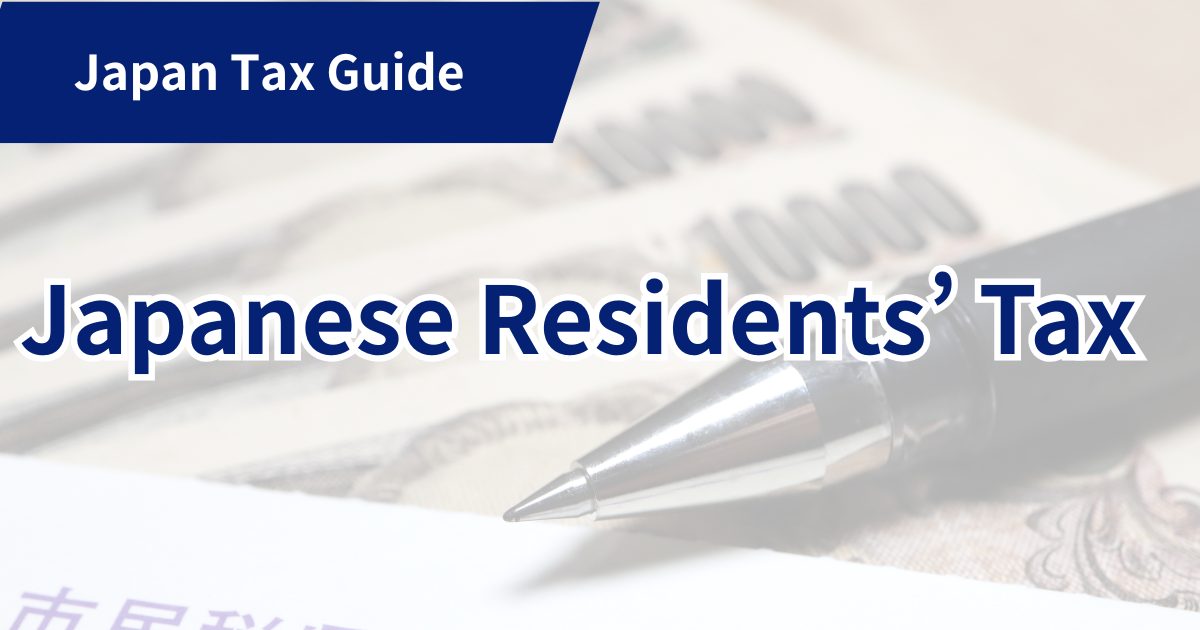Contents
Tax rate
Resident’s tax is comprised of two portions: The income-based portion and the per-capita portion.
- Income-based portion: Flat rate of 10% (prefectural rate: 4%, municipal rate: 6%) on taxable income.
- Per-capita portion: Consists of prefectural tax of JPY 1,000 and municipal tax of JPY 3,000. Starting in 2024, a “forest environment tax” of JPY 1,000 is added, bringing the total to JPY 5,000 per year.
Incomes subject to separate taxation for income tax purposes may be subject to a reduced residents’ tax rate of 5%. These include:
- Bank deposit interest
- Capital gains on sale of listed stock
- Dividends on listed stock
- Lump-sum retirement allowance
For these types of income, residents’ tax is generally withheld at source along with income tax.
Schedule
Residents’ tax is assessed based on the individual’s residence as of January 1 of the relevant year. If an individual did not reside in Japan on January 1, no residents’ tax obligation arises for that year.
Residents’ tax is calculated based on income from January 1 to December 31 of the previous year, which is declared annually.
For salaried employees, the employer reports the employee’s salary to their resident municipality after year-end adjustment.
Meanwhile, for non-salaried individuals (e.g., sole proprietors), this information is reported in their annual tax return.
From late May to early June, municipalities send a notification of the annual residents’ tax amount to the employers.
Employers then withhold residents’ tax from the employee’s salary from June of the current year through May of the subsequent year.
Non-salaried individuals receive four payment slips (one per installment) for direct payment by June, August, October, and January. Exact dates vary by municipality.

Ordinary Collection and Special Collection
The payment of residents’ tax in four installments is known as ordinary collection. It is typically used by sole proprietors, freelancers, individuals between employment, and retirees. The four installments may also be paid in lump-sum by the first installment deadline.
Meanwhile, the withholding of residents’ tax from salary every month is known as special collection.
Special collection falls under the duty of the employer.
Excluding special circumstances, such as when the total number of employees is two or less, the employer is in principle required to use special collection for its employees’ residents’ tax.
Salaried employees may also switch between collection methods in circumstances such as resignation.
If resignation falls between June to December, the employer is required to switch the employee’s payment method from special collection to ordinary collection, unless the employee opts to have the remaining tax deducted from their final salary in full.
If resignation falls between January to May, the remaining tax is in principal deducted from the employee’s final salary.
If at the time of resignation the next employer is already determined, the previous employer may submit a notification to transfer the withholding duty to the new employer, maintaining special collection status.
Payment of Resident’s Tax for Special Collection
Residents’ tax withheld by the employer must be remitted to the employee’s municipality by the 10th of the following month.
Companies with nine or fewer employees may apply a special rule to pay twice a year (December and June) instead of monthly.
Payment can be made in person (using the payment slip issued by the municipality) or online. For in-person payments, a separate payment slip is required for each unique municipality where employees reside.
Payments for multiple employees residing in the same municipality are aggregated.
If using eLTAX for online payment, payments to multiple municipalities are consolidated in a single payment to the Local Tax Agency.
TOMA’s Services
The handling of employees’ residents’ tax is a critical part of tax compliance in Japan.
At TOMA, our specialists in payroll and tax can help you navigate reporting, withholding, and payment of resident’s tax. Please contact us if you require consultation and support.





